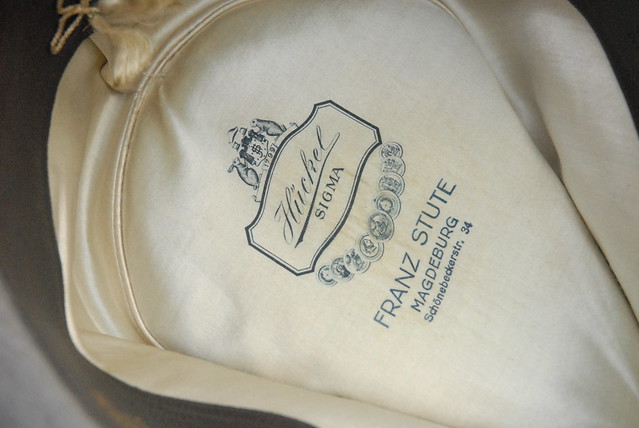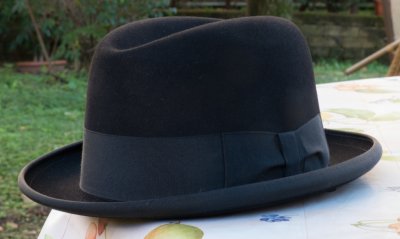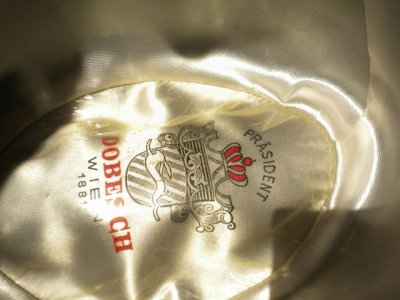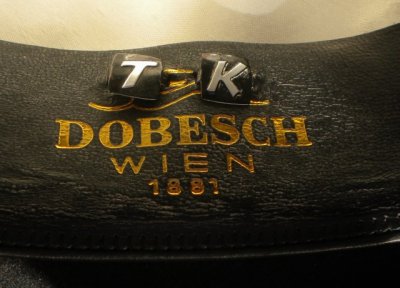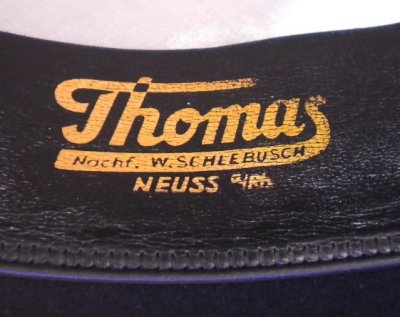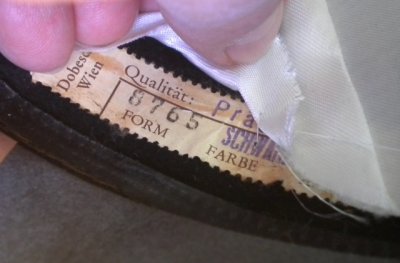- Messages
- 17,709
- Location
- Maryland
Rehfus history found by Manfred.
here is a Google Translation of the History of Rehfus.
Two step-brothers Rudolf Ferdinand and John Carl Rehfus, who had learned both the merchant craft, built in 1867 in the village of Kehl-hat factory Rehfus.
The hat factory Rehfus'sche could quickly claim due to the excellent quality of their hats on the market. 1895 the company employed about 170 employees. Initially, only hats made of rabbit hair and rabbit hair were made. With the start of the new century, the fashion changed and the Hatter Rehfus'schen rose successfully to the production of lightweight stiff hats (popularly known as melon) around.
Charlie Chaplin made the melon acceptable and gave the models Rehfus'schen »Aerifor," "paradox" and "Zephyr" good sales. Even in South America, Holland, England and Scandinavia was one of melons throat. "Furs are sold in Leipzig, in stiff hats Rehfus in Kehl," read a slogan from England. The racer from the house Rehfus was the "Upper Country", a hat made of waterproof tumbled fur, found mainly in the hunting circles very popular and was made after the First World War as a normal Straßenhut in all colors and shapes.
1890, Carl-Johann Rehfus leads the business in hand. He was ten years ago joined the company as general manager. His second passion next to the company was hunting. The family owned a large area on the small Kronenhof and Carl-Johann was touched as a boy with his friend, the son of the Upper Hunter Fritz, through the extensive coppices. Later he moved into distant climes, to moose hunting or bear hunting by Norway to Russia.
Under the pseudonym of "Upper Countries", he published numerous books that have become classics of hunting literature. His passion was so great that he did sign in 1907 the additional name "Upper Country" at the Karlsruhe Department of Justice.
Carl-Johann Rehfus Oberländer died in 1926. In his footsteps, his son Carl-Hans, who had joined the company in 1908 and how his father was an avid hunter.
After the war, until 1951, the work can be resumed. During the occupation, the factory had been looted and damaged, only months-long cleanup and a credit under the Marshall Plan could start production again. But the fashion changed again and brought an entire industry to stumble - you went (s) now without a hat. In 1963, the Rehfus'sche hat factory closed its doors forever. The competition did not fare any better: in 1970, of the 30 hat factories in the country that housed the entire production line under one roof, remains only five.
Carl-Hans-Rehfus Oberländer died in 1976. The last representative of the traditional family is the now 88-year-old hat maker, interpreter and photographer Maria Rehfus-Oberlander, who returned after the death of her father's throat in order to take care of her mother Alice.
Today the gatehouse of the former hat factory Rehfus'schen sitting cross-border and European institutions. The inn "Rehfus" on the main street was demolished 1954th The site now serves as the post office parking lot.
here is a Google Translation of the History of Rehfus.
Two step-brothers Rudolf Ferdinand and John Carl Rehfus, who had learned both the merchant craft, built in 1867 in the village of Kehl-hat factory Rehfus.
The hat factory Rehfus'sche could quickly claim due to the excellent quality of their hats on the market. 1895 the company employed about 170 employees. Initially, only hats made of rabbit hair and rabbit hair were made. With the start of the new century, the fashion changed and the Hatter Rehfus'schen rose successfully to the production of lightweight stiff hats (popularly known as melon) around.
Charlie Chaplin made the melon acceptable and gave the models Rehfus'schen »Aerifor," "paradox" and "Zephyr" good sales. Even in South America, Holland, England and Scandinavia was one of melons throat. "Furs are sold in Leipzig, in stiff hats Rehfus in Kehl," read a slogan from England. The racer from the house Rehfus was the "Upper Country", a hat made of waterproof tumbled fur, found mainly in the hunting circles very popular and was made after the First World War as a normal Straßenhut in all colors and shapes.
1890, Carl-Johann Rehfus leads the business in hand. He was ten years ago joined the company as general manager. His second passion next to the company was hunting. The family owned a large area on the small Kronenhof and Carl-Johann was touched as a boy with his friend, the son of the Upper Hunter Fritz, through the extensive coppices. Later he moved into distant climes, to moose hunting or bear hunting by Norway to Russia.
Under the pseudonym of "Upper Countries", he published numerous books that have become classics of hunting literature. His passion was so great that he did sign in 1907 the additional name "Upper Country" at the Karlsruhe Department of Justice.
Carl-Johann Rehfus Oberländer died in 1926. In his footsteps, his son Carl-Hans, who had joined the company in 1908 and how his father was an avid hunter.
After the war, until 1951, the work can be resumed. During the occupation, the factory had been looted and damaged, only months-long cleanup and a credit under the Marshall Plan could start production again. But the fashion changed again and brought an entire industry to stumble - you went (s) now without a hat. In 1963, the Rehfus'sche hat factory closed its doors forever. The competition did not fare any better: in 1970, of the 30 hat factories in the country that housed the entire production line under one roof, remains only five.
Carl-Hans-Rehfus Oberländer died in 1976. The last representative of the traditional family is the now 88-year-old hat maker, interpreter and photographer Maria Rehfus-Oberlander, who returned after the death of her father's throat in order to take care of her mother Alice.
Today the gatehouse of the former hat factory Rehfus'schen sitting cross-border and European institutions. The inn "Rehfus" on the main street was demolished 1954th The site now serves as the post office parking lot.
Last edited:


